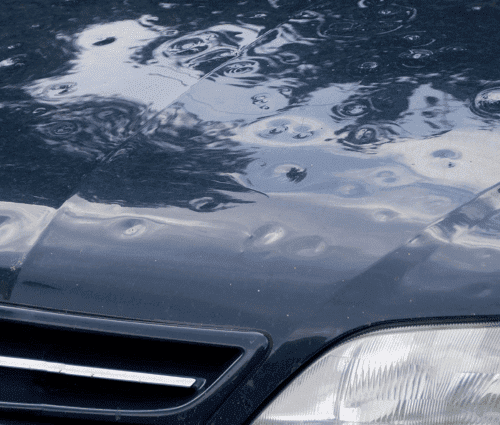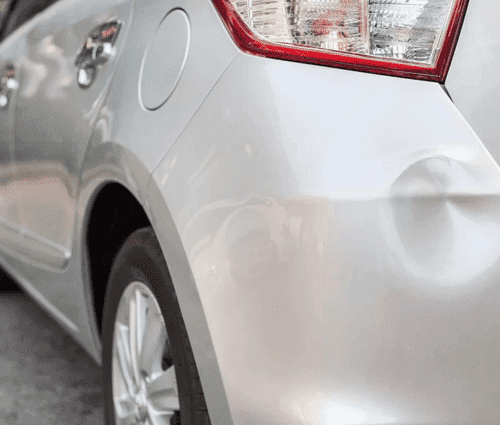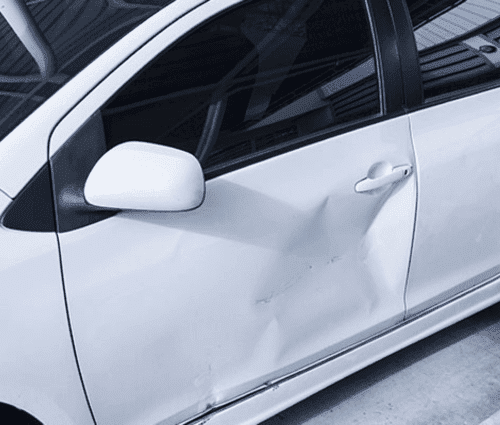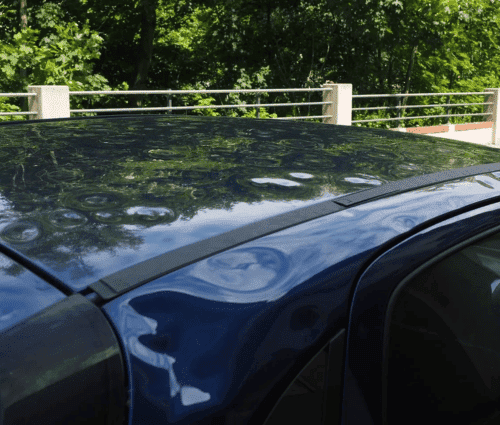Understanding How Vehicle Hail Damage Repair Costs Are Calculated
Factors That Influence the Cost of Vehicle Hail Damage Repair

When your vehicle is damaged by hail, one of the first questions that come to mind is, how much will it cost to repair? The hail damage repair cost depends on various factors, such as the severity of the damage, the number of dents, and the chosen repair method. Every dent is different, and repair costs are calculated based on several key variables that directly impact the pricing.
We’ll break down the most important factors that determine vehicle hail damage pricing. Understanding these factors will help you get a more accurate repair estimate and make informed decisions when selecting a repair method, whether it’s Paintless Dent Repair (PDR) or traditional bodywork.

The Severity of the Hail Damage Affects the Overall Repair Cost
The severity of the hail damage is one of the biggest factors that influence the cost of repair. This severity is typically measured by the size and depth of each dent. Hailstorms can vary in intensity, and so can the resulting damage. For instance, a car hit by small hailstones may suffer shallow dents, while larger hailstones can cause deep, more complex dents that require more work to repair.
Larger and deeper dents take longer to fix, especially if they occur in difficult-to-reach areas of the car, such as around edges or on curved surfaces. A hail damage repair cost will increase if the dents are particularly severe, as they require more detailed work to restore the vehicle to its original condition.
In addition to the dent size and depth, the location of the dent on the vehicle can also affect the cost. For example, dents on the roof or hood are typically easier to access and fix compared to those on the vehicle’s doors or panels, which may require more disassembly to reach the affected areas.
The Number of Dents on the Vehicle Significantly Impacts Pricing

Another factor in determining vehicle hail damage pricing is the total number of dents. After a hailstorm, it’s not uncommon for cars to sustain hundreds of small dents scattered across the surface. The more dents there are, the longer it will take to repair the vehicle, which directly raises the overall cost of the repair.
For every dent, technicians must perform the same careful work, the metal is restored to its original form. Even if the dents are small, the cumulative effect of repairing dozens or even hundreds of dents will increase labor time and cost.
This is where Paintless Dent Repair (PDR) can be a more cost-effective solution, especially when dealing with a high volume of small, shallow dents caused by hail.

Technicians will often calculate the total estimate for hail damage based on the number of dents, typically grouping them into ranges. For example, a repair estimate may categorize dents as 1-10, 11-25, or 26-50, with the price increasing with each tier. Understanding how the number of dents factors into the overall cost can help vehicle owners better anticipate the final repair bill.
Why the Location of the Dents on Your Car Can Affect Repair Costs
The location of the dents on your car also plays a significant role in determining the hail damage repair cost. Dents that occur on flat, accessible surfaces, such as the hood, roof, or trunk, are generally easier to repair and therefore less expensive. These areas allow technicians to access the dent easily from the underside of the panel, making PDR the ideal and most affordable repair method.
Dents located in more complex areas, such as the edges of doors, near window seals, or on fenders, often require additional steps to repair. These areas may involve removing parts of the interior trim or other components to reach the dent from behind, increasing the labor involved. The more complex the location, the higher the cost of the repair.
In cases where the dent is in a particularly hard-to-reach spot, traditional repair methods may need to be considered, which can add to the overall expense. PDR is highly effective for most dent locations, but when a dent cannot be accessed with PDR tools, conventional bodywork might be required, leading to higher repair costs.
Comparing Paintless Dent Repair and Traditional Repair Methods
Paintless Dent Repair (PDR) is widely recognized as a highly cost-effective solution for repairing hail damage, especially when dents are minor and the paint remains intact. Since PDR does not involve repainting or using body filler to repair dents, it requires fewer materials and less time to complete the repair. This leads to lower labor costs and reduced overall expenses, making PDR hail damage repair a more affordable option for many vehicle owners seeking efficient and high-quality service. Additionally, the streamlined process often allows for faster turnaround times.

Traditional bodywork involves sanding down the damaged area, filling in the dent with body filler, and repainting the affected area to match the rest of the car. This process is much more labor-intensive and requires additional materials, such as primer, paint, and clear coat. As a result, traditional repair methods are generally more expensive than PDR.
For deeper dents or when the paint has been damaged, traditional bodywork may be the only option.
The cost difference between PDR and traditional repairs depends on the extent of the damage and the location of the dents. For small to medium dents, PDR is almost always the more affordable option, while more severe dents may require traditional repair methods, which will increase the overall repair cost.
How Insurance Coverage Impacts the Pricing of Hail Damage Repair
Insurance coverage plays a significant role in determining how much vehicle owners will ultimately pay for hail damage repair. Most comprehensive auto insurance policies cover hail damage, but it’s important to understand how your specific policy handles repair costs and deductibles. When filing an insurance claim for hail damage, the insurance company will typically cover the cost of repairs minus the deductible. The deductible is the amount the policyholder is responsible for paying out of pocket before insurance coverage kicks in.
For example, if your repair costs $1,500 and your deductible is $500, the insurance company will cover $1,000, leaving you to pay the remaining $500. Many insurance companies prefer Paintless Dent Repair (PDR) because it is more affordable than traditional bodywork and helps keep claim costs lower. This can benefit vehicle owners, as it may make it easier to have the repair covered without exceeding the vehicle’s value or running into issues with total loss claims.
Insurance companies may require an inspection of the vehicle before approving the repair. They will assess the number of dents, the severity of the damage, and the chosen repair method that the repair costs are justified. To maximize your claim benefits, it’s essential to understand the details of your policy and work with a repair shop that is experienced in dealing with insurance claims for hail damage repair.
The Importance of Getting an Accurate Estimate for Hail Damage Repair

Before committing to any repair work, it’s important to get an accurate estimate for the hail damage repair cost. A comprehensive estimate will give you a clear understanding of how much the repair will cost, whether your insurance will cover the expenses, and what options are available for fixing your vehicle. Most repair shops that specialize in hail damage repair offer free estimates. During the estimate process, the technician will carefully assess the damage, taking into account the number of dents, their size and depth, and their location on the vehicle.
This evaluation helps determine whether PDR or traditional repair methods are required and provides a breakdown of the overall cost.

Understanding the Key Factors in Pricing Vehicle Hail Damage Repairs
The cost of repairing hail damage is influenced by several factors, including the size, depth, and location of the dents, as well as the chosen repair method. Paintless Dent Repair (PDR) is often the most cost-effective solution, particularly for minor dents, but traditional repair methods may be necessary for more severe damage.
The number of dents on your vehicle can significantly impact the overall repair cost, especially after a severe hailstorm. Insurance coverage can also play a major role in determining how much you’ll pay out of pocket, making it important to understand your policy and work with an experienced repair shop. By getting a detailed estimate and considering your repair options carefully, that your hail damage repair is completed at a fair price while maintaining the quality and appearance of your vehicle.

VIP Hail Service | Plano, TX
Professional Hail Repair
Stay Up-to-date With Our Content
Subscribe to learn more about our mission!


